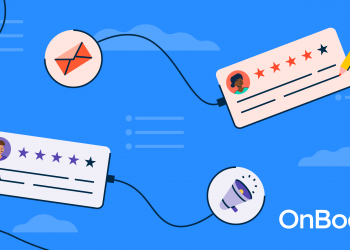Cross-Selling and Upselling: The Ultimate Guide (2022) – crowdspring Blog
The potential revenue you can get from a customer doesn’t end at the point of sale.
You still have many opportunities to drive sales beyond the initial purchase. The marketing tactics known as cross-selling and upselling can help you tap into those opportunities.
Cross-selling and upselling increase your income by enticing clients to spend more. It’s a win-win situation where consumers get a superior experience, and you make more money.
But, it’s easy to misuse these marketing tactics.
Some businesses jump in too early, ignore the buyer’s intent, pick the wrong approach, and often annoy customers instead of improving their experience.
This guide will dive deeply into the best practices around upselling and cross-selling. The guide will help you delight customers and deliver more value while driving additional revenue growth for your business.
Cross-Selling and Upselling
What is cross-selling?
Cross-selling is a sales tactic that encourages the purchase of additional products or services in conjunction with what the customer is already purchasing.
Cross-selling usually involves additional product recommendations and offers like: “If you like this, you might also like this.”
In cross-selling, you’re not just promoting a random additional product. The other product you promote must be complementary to what your customer already agreed to buy. Cross-sells are most effective when offered as enhancements, not requirements.
The goal is to help the customer maximize the value they get from the initial purchase or enhance their experience with the product.
Such products generally belong to different categories but will be complementary. For example, you can cross-sell a carrying case with a laptop or socks with a pair of shoes.
What is upselling?
Upselling encourages customers to purchase more expensive items or services by offering an upgrade, enhancement, or premium option.
Where cross-selling offers complementary products, upselling aims to swap out the original purchase for a higher-end item that presents greater value to the customer.
In short, when you upsell, you’re “piling on” on a product rather than “building around” it.
When upselling, a superior version of the original purchase will usually be a higher, better product model or the same product with value-added features that increase its perceived value.
Why upselling and cross-selling are essential for eCommerce
Upselling and cross-selling are frequently (and mistakenly) assumed to be unethical tactics for getting more money from the customer.
And these techniques are frequently abused and implemented incorrectly.
But if you cross-sell and upsell by following best practices, you can help customers win too.
These tactics should be geared towards making suggestions that might better suit a client’s current needs while also assisting them in making an informed decision by fully informing them about their choices.
So, how does cross-selling and upselling help your business?
1. Cross-selling and upselling increase profits
It’s no secret that a customer who buys more generates more income for your business.
A well-rounded and effective cross-selling and upselling strategy will help boost your revenue and profits.
The great untapped market in your business might be your existing customers.
Pro-tip: The correct language for your call-to-action (CTA) or lead magnet is crucial when cross-selling or upselling. Your copy should arouse customers’ curiosity while providing real value to them. This helps them build their loyalty and trust in your business and creates more substantial brand equity for your business.
Want a free brand review?
Answer 5 short questions and we will send a custom report with actionable insights and specific actions you can take to build a stronger brand.
We just emailed the info to you.
2. Cross-selling and upselling increase customer loyalty
Upselling is sometimes associated with sleazy automobile salespeople attempting to persuade clients to purchase goods and services they don’t need.
In reality, however, this is far from the case. Upselling allows customers to make an informed selection by providing them with all their alternatives. It demonstrates that you care and expect your customers’ preferences to be met.
When done correctly, upselling and cross-selling are associated with customer happiness. People develop loyalty to firms that appear to care for their financial well-being.
Customers can be fickle, and it’s too easy for them to become dissatisfied and leave quickly. Any strategy that a company can use to increase loyalty will help minimize the costs of losing customers, especially new ones.
Customer satisfaction decreases churn rates and offers a significant opportunity for free marketing.
In today’s world, few individuals would entrust their business to an organization without first checking its reputation. The greatest type of advertisement you can’t purchase is a satisfied consumer.
3. Cross-selling and upselling increase your ROI
You’ve already done the difficult job of marketing, discovering, and selling successfully to your client; it’s time to get as much out of the encounter as possible for your business.
When you ignore upselling and cross-selling, you leave money on the table. Make an effort to offer customers products that are relevant and those that add value to their experience.
4. Cross-selling and upselling increase Customer Lifetime Value
There is a 60-70% higher chance of getting a sale from an existing customer than targeting new ones. Strategically, it makes sense to target existing customers first.
It’s also critical to note that offering value-driven improvements (when upselling) and everyday items (when cross-selling) to clients can boost order value in the short term and client lifetime value in the long run.
Here are some cross-selling ideas to try and entice customers and increase customer lifetime value:
- Sending customized emails to clients about items that could be of interest to them; and
- Offering discounts, special offers, or giving customers free items and loyalty incentives.
Increased customer loyalty can pay off handsomely in the long run. Not only will you improve customer lifetime value by increasing the value of their purchases, but you’ll also gain a more dedicated client. You’ll notice a significant difference when dealing with a customer who is loyal to you. In addition, increased client loyalty has benefits in the long term.
5. Cross-selling and upselling balance new and existing customer growth
Increasing customer retention by as little as 5% also increases profits from 25% to 95%.
Maintaining a balance between the people who sign up initially and those you retain is critical to your business’s health. Keep a healthy balance between new and existing clients to help guarantee that your company is making money.
This can be achieved by upselling and cross-selling. Customers who feel a business continues to look after their interests by providing relevant and helpful items and services are far more likely to continue purchasing from you.
6. Cross-selling and upselling offer convenience and flexibility for customers
The advantages of upselling and cross-selling aren’t limited to businesses and enterprises. It works well for their customers too.
Many customers do not want to shop for a new brand every time they search for a product or service. Offering them more choices or relevant add-ons reduces the risk of losing customers to a competitor.
Many customers will stay with a brand they’re already familiar with and with what they like, especially if they know what is being made available.
You can strike while the iron is hot and offer related products and services as soon as you earn customer confidence.
When you upsell or cross-sell to a client, you provide them with the ease of access and flexibility of choice that comes from staying with you.
How you can cross-sell or upsell
Lowering complexity and narrowing options can boost revenues by 5-40% while reducing costs by 10-35%. Cross-selling and upselling can be rewarding when executed optimally.
Here are some tried and tested ways that you can use cross-selling and upselling effectively in your business:
1. Upsell by strategically reducing choices
Have you ever heard of the paradox of choice principle? It’s a phenomenon that’s all too familiar to a prospective buyer looking at too many alternatives to choose from.
Refrain from bombarding your customers with too many choices. If they’ve already said no to an upsell product, don’t push for it. Upsells should be seen as a suggestion rather than an aggressive sales approach.
2. Offer bundles to reduce the paradox of choice
Every action a customer takes throughout the customer journey adds another layer of complexity to the decision-making. People have limited energy available for this thought process, so be a step ahead of them and think of ways to make choice-making easier.
Buying each item individually involves more steps and more decision-making. Bundling offers a suite of related products that are relevant to a customer. Through bundling, a customer can buy multiple products all in one go.
3. Don’t be pushy or aggressive
Use data and client behavior to provide customized recommendations that are most likely to fulfill their requirements or address an existing or potential problem. And offer social proof to show that others have purchased similar combinations of products or upgraded their original choices.
Here’s what you shouldn’t do:
- Suggest upsells and cross-sells before a customer selects a product,
- Overwhelm customers with too many cross-sell and upsell choices,
- Use sly tactics such as hiding pre-selected add-ons in the hope customers don’t notice it,
4. Don’t neglect post-purchase cross-selling
Cross-selling doesn’t end once the customer has checked out.
The experience following the purchase is, in fact, a pivotal moment in the consumer journey for many eCommerce firms. Don’t just send the goods and the receipt; use the opportunity to build consumer loyalty while offering amazing deals.
Offer customers additional products, incentives, and value after purchasing by employing emails, confirmation pages, and other post-purchase communications.
We regularly update this cross-selling and upselling guide. We most recently updated this guide on September 15, 2022.
Interested in other types of businesses or how-to guides? Here are our comprehensive guides:
How to Start a Business: The Complete Step-by-Step Guide to Starting a Business in 2022
How to Write a Business Plan (2022)
How To Create an Effective Marketing Plan for Your Business (2022)
How to Start an LLC in 7 Simple Steps (2022)
Branding: The Definitive Guide for 2022
The Definitive Guide to Successfully Rebranding in 2022
What is Brand Identity? And How to Create a Unique and Memorable One in 2022
The Ultimate Small Business Guide to Brand Equity in 2022
Brand Archetypes and How They Can Help Your Business: The Definitive Guide
The Definitive Small Business Guide to Brand Pillars in 2022
How to Tell a Compelling Brand Story About Your Business [Guide + Examples]
The Complete Guide on How to Name a Business
Brand Strategy 101: How to Create an Effective Branding Strategy [GUIDE]
The Definitive Content Marketing Guide
Social Media Marketing: The Ultimate Small Business Guide for 2022
Local SEO: The Definitive Small Business Guide (2022)
Marketing Funnels: The Definitive Small Business Guide (2022)
Cross-Selling and Upselling: The Ultimate Guide (2022)
How to Start a Small Business Blog
Small Business Guide to Lifecycle Email Marketing: How To Grow Your Business Faster
Direct to Consumer (DTC) Marketing: The Complete Guide, with Strategies, Tactics, and Examples (2022)
Google Ads: The Ultimate Small Business Guide (2022)
The Ultimate Guide to Using Twitter for Business in 2022
YouTube Marketing: The Complete Small Business Guide 2022
Instagram Marketing: The Ultimate Small Business Guide for 2022
How to Use LinkedIn: The Ultimate Small Business Marketing Guide
The Ultimate Small Business Guide to Marketing on TikTok
How to Start A Podcast: A Complete Step-by-Step Guide (2022)
SMS Marketing: The Ultimate Small Business Guide [2022]
Public Relations Guide for Small Business (7 Proven PR Tactics)
How to Start a Consulting Business in 2022: The Complete Step-by-Step Guide
How to Start a Real Estate Business in 2022: Complete Step-by-Step Guide
How to Start a Trucking Business in 2022: The Complete Guide
How to Start a Candle Business: A Step-by-Step Guide With Tips and Insights (2022)
How to Start a Property Management Company
How to Start a Successful Online T-Shirt Business in 2022: The Definitive Guide
How to Start an eCommerce Business: A Step-by-Step Guide To Take Your Business Online (2022)
Nonprofit Branding: Complete Guide to Building a Strong Nonprofit Brand in 2022
How to Start a Cleaning Business in 2022: The Complete Guide
6 Businesses You Can Start For Less Than $1,000
Marketing Psychology: What You Must Know To Supercharge Your Marketing
What is a DBA and How to File One For Your Business
How to Start a Clothing Line or Clothing Brand From Scratch in 2022: The Definitive Guide
How to Start a Brewery Business in 2022: The Complete 9 Step Guide
How to Start a Medical Marijuana Dispensary Business in 2022
How to Start an Etsy Shop: Your Comprehensive, No-Stress Guide to Starting an Etsy Shop in 2022
How to Start a Photography Business in 2022: The Complete Step-by-Step Guide
How to Start a Business in Texas: The Complete Step-by-Step Guide (2022)
The Definitive Guide to Creating a Compelling Visual Brand for Your Restaurant in 2022
Conversion Rate Optimization (CRO) Guide: How to Make Your Website Work Smarter (2022)
Facebook Messenger Chatbot Marketing: The Definitive Guide (2022)
Branding for Food Trucks: The Definitive Guide (2022)
Source by www.crowdspring.com











